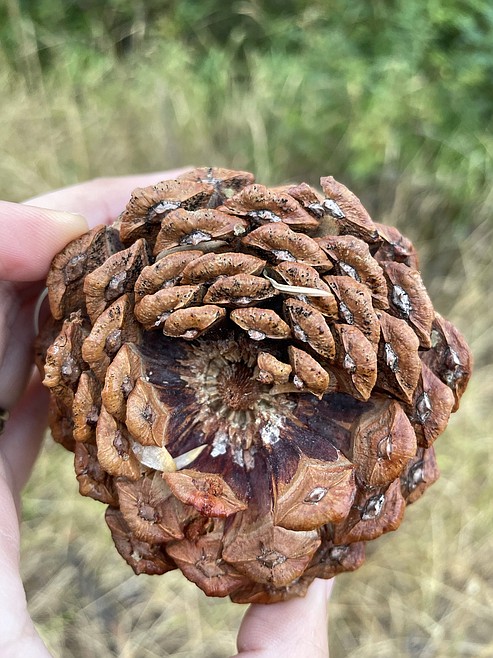Hail storm leaves ‘sores and cankers’ on pine trees around Bigfork
A hailstorm that caused widespread damage across the Flathead in July is to blame for an infection in some pine trees, according to the Montana Department of Natural Resources and Conservation.
Red foliage growing from ponderosa pines, as well as red “sores or cankers” on pinecones, consistent with the fungus diplodia, have been reported near Bigfork, Woods Bay and Echo Lake.
Foresters and forest pathologists from the state agency and the U.S. Forest Service determined that the hailstorm that blew in around 5 p.m. on July 9 is the cause of the damage and resulting red foliage, according to a release from DNRC. Ping-pong ball sized hail combined with 60 mile per hour wind gusts bruised the branches of trees already stressed from long-term drought conditions, activating a latent diplodia shoot blight infection.
“An investigation of the impacted area found branches that had broken off were resinous and brittle, consistent with old diplodia cankers, and that diplodia spores were present on cones and needles on the ground,” DNRC Service Forester Holly McKenzie said. “In addition, wounds visible on branches were indicative of hail damage.”
DNRC Forestry Assistance Specialist Ali Ulwelling said the fungus was already latent in the trees due to stressful conditions. The bruising and moisture from the hail storm activated those fungal spores. There is a large concentration of ponderosa pines around Bigfork, and Ulwelling said that contributes to stressful conditions as well.
“The trees are already a little bit overstocked and ponderosa pines like wide crown spacing. It gets a little crowded and so there's this competition for resources, for water— and then we've had this drought and they're already stressed, so having a hailstorm with 60 mile an hour winds just further exacerbated things,” Ulwelling said.
Trees have been impacted to varying degrees. The ones located at the edge of the forest received the direct force of wind and hail more than those protected in the interior. McKenzie said trees that maintain green needles may recover, but those with substantial reddening will likely continue to brown and experience dieback.
It is difficult to predict what the outcome will be, but another problem could follow the blight. As trees fade, landowners should pay close attention to possible bark beetle infestations in the area. The western pine beetle and Ips beetle will attack stressed ponderosa pine trees, especially overstocked stands affected by drought.
“Because they're already stressed by drought, they don't have a lot of pitch to out the beetles, so that won't be a telltale sign. They're quite small, so people may not even notice them, and the needles are red because they're already damaged. So the beetles could move into the trees and people might not know,” Ulwelling said.
Ponderosa pines have a defense mechanism against beetles that involves producing resin as the bug tries to burrow further into its bark. Eventually, after fighting the continuous ooze of resin, the beetle will tire out and die. But, ponderosa pines impacted by drought conditions might not have enough water content to produce the resin needed to oust the beetles.
The DNRC said bubble caps and verbenone hormones often used to preemptively repel the mountain pine beetle will not work in this situation.
McKenzie said landowners should continue to keep a close eye on the situation and remove dead trees as quickly as possible. Watering may help stressed trees to recover, but fertilizer should not be applied as high nitrogen levels in the soil have been linked to increased incidence and severity of diplodia shoot blight.
Dead branches may be pruned for aesthetic reasons but will not impact the overall health of the tree, pruning should be avoided during wet weather to avoid further spread of fungal spores.
It’s unclear how this case of blight will affect the trees going forward. With more reports of damaged trees coming in from other parts of the Flathead Valley, Ulwelling said the DNRC will continue to monitor the trees' conditions to see whether the trees recover or not.
“It's going to be an ongoing story of what's going to happen next,” Ulwelling said.


